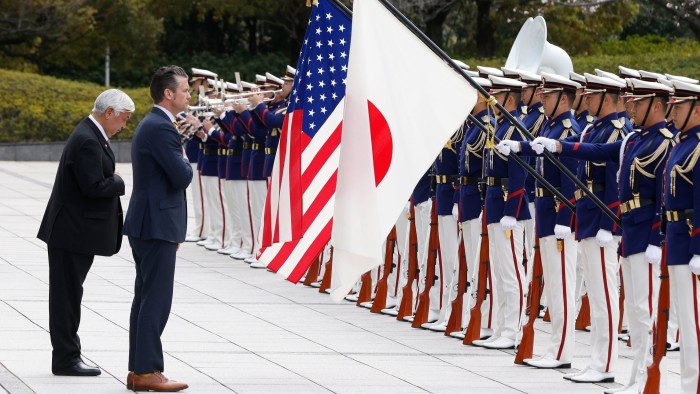Unlock the White House Watch newsletter for free
Your guide to what the 2024 US election means for Washington and the world
US defence secretary Pete Hegseth said America had begun upgrading its military forces in Japan to set up a “war-fighting” headquarters, as the allies attempt to build a more formidable deterrence against China.
The upgrade, the first phase of a reorganisation of US forces in Japan announced under the Biden administration, would improve their ability to co-ordinate operations with Japan’s Self-Defence Forces and “keep the enemy guessing” by creating strategic dilemmas in the region, Hegseth said on Sunday.
“Peace through strength with America in the lead is back,” he added.
Hegseth was speaking in Tokyo at the end of a visit to Japan that included a commemorative ceremony on Iwo Jima, the remote Pacific island where fighting between Japan and the US in the second world war claimed huge casualties on both sides.
In the decades following that conflict, Japan had been a “model ally” of the US, Hegseth said at a joint press conference with his Japanese counterpart, Gen Nakatani. About 55,000 US military personnel are stationed at air, naval and marine bases across Japan.
In comments that appeared aimed at soothing concerns in Tokyo about the durability and reliability of the countries’ partnership under the Donald Trump’s presidency, Hegseth said the US-Japan military alliance remained the cornerstone of peace and security in the Indo-Pacific region.
“President Trump has also made it very clear . . . we’re going to put America first. But America First does not mean America alone,” he said. “America’s warriors stand shoulder to shoulder every day with their Japan self-defence Force counterparts.”
Hegseth made similar assurances on a visit to the Philippines on Friday, where he reaffirmed Washington’s “ironclad alliance” with Manila to strengthen deterrence in the Pacific.
Trump’s recent comments questioned the validity of long-standing alliances and unsettling Nato allies and reverberated in Asia. Japan, which considers itself Washington’s closest ally in the region, depends heavily on the US security umbrella.
Trump earlier this month described the US-Japan treaty as “an interesting deal with Japan that we have to protect them, but they don’t have to protect us” — comments that caused raised fears among Japanese officials that Hegseth would use the visit to demand Tokyo spend a greater proportion of its GDP on defence, possibly through the economic threat of tariffs on Japanese automotive exports.
Elbridge Colby, Trump’s nominee for under-secretary of defence, said earlier this month that Japan should boost defence spending beyond the current target of 2 per cent of GDP by 2027.
But both Nakatani and Hegseth said that their 85-minute summit had not included discussion of specific military spending targets for Japan.
Nakatani said that Japan was making efforts to “drastically strengthen” the country’s defence capabilities, but added that he had emphasised to Hegseth that it was important for Japan to proceed “at its own discretion”.
Hegseth said, however, that both the US and Japan had to recognise that they needed to do more to present a credible deterrence to China.
“Our job at the defence department with our friends on the military side is to build an alliance so robust that both the reality and the perception of deterrence is real and ongoing so that the Communist Chinese don’t take the aggressive actions that some have contemplated they will,” said Hegseth.
Read the full article here




